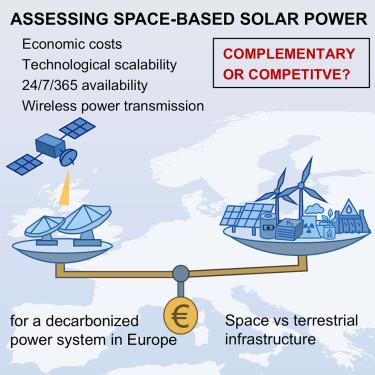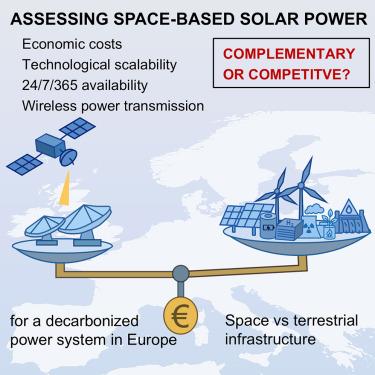评估天基太阳能在欧洲规模的电力系统脱碳中的应用
IF 35.4
1区 材料科学
Q1 CHEMISTRY, PHYSICAL
引用次数: 0
摘要
由于陆地可再生能源面临间歇性和区域性限制,实现净零目标具有挑战性。在这里,我们使用高分辨率的欧洲范围内的容量扩张和调度模型来评估基于空间的太阳能发电,这是一个近乎恒定的来源。我们评估了两种先进的设计:(1)接近基本负荷,低trl(技术就绪水平)定日镜设计;(2)部分间歇,更高trl的平面设计,使用NASA的2050年预测。我们发现定日镜设计可以将系统总成本降低7%-15%,抵消高达80%的风能和太阳能,并减少超过70%的电池使用量,尽管氢对于季节平衡仍然至关重要。相比之下,平面设计在其预测成本上是不经济的。敏感性分析揭示了两种设计的相对成本阈值,在该阈值上,天基太阳能从成本过高转变为互补,并最终成为净零转型的主要基本负荷来源。这些结果提供了强有力的技术经济基准,突出了新的净零排放途径,并指导政策制定者和行业走向大规模、低间歇性的可再生能源。本文章由计算机程序翻译,如有差异,请以英文原文为准。


Assess space-based solar power for European-scale power system decarbonization
Meeting net-zero targets is challenging, as terrestrial renewables face intermittency and regional constraints. Here, we assess space-based solar power, a near-constant source, using a high-resolution, Europe-wide capacity-expansion and dispatch model. We assess two advanced designs: (1) a near-baseload, low-TRL (technology readiness level) heliostat design and (2) a partially intermittent, higher-TRL planar design, using NASA’s 2050 forecast. We find that the heliostat design can cut total system costs by 7%–15%, offset up to 80% of wind and solar, and reduce battery usage by over 70%, although hydrogen remains vital for seasonal balancing. The planar design, by contrast, is uneconomical at its forecast costs. Sensitivity analyses reveal relative cost thresholds for both designs, at which space-based solar shifts from cost-prohibitive to complementary and ultimately to a dominant baseload source for net-zero transitions. These results provide robust techno-economic benchmarks, highlighting new net-zero pathways and guiding policymakers and industry toward large-scale, low-intermittency renewables.
求助全文
通过发布文献求助,成功后即可免费获取论文全文。
去求助
来源期刊

Joule
Energy-General Energy
CiteScore
53.10
自引率
2.00%
发文量
198
期刊介绍:
Joule is a sister journal to Cell that focuses on research, analysis, and ideas related to sustainable energy. It aims to address the global challenge of the need for more sustainable energy solutions. Joule is a forward-looking journal that bridges disciplines and scales of energy research. It connects researchers and analysts working on scientific, technical, economic, policy, and social challenges related to sustainable energy. The journal covers a wide range of energy research, from fundamental laboratory studies on energy conversion and storage to global-level analysis. Joule aims to highlight and amplify the implications, challenges, and opportunities of novel energy research for different groups in the field.
 求助内容:
求助内容: 应助结果提醒方式:
应助结果提醒方式:


